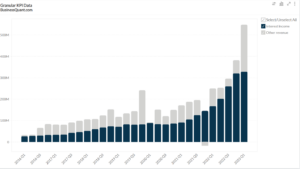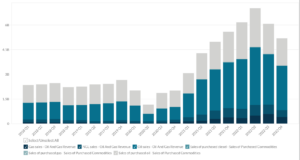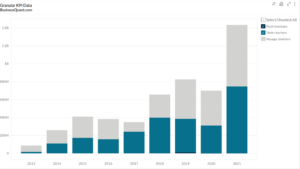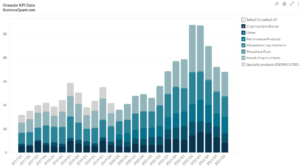
Dillard’s Revenue Breakdown Worldwide (2016-2023)
Exclusive Data
You need the Pro Plan to access KPI data
- Full access to the platform
- KPI data & segment financials on US stocks
- Financial data on thousands of stocks
- Download data in xlsx and csv formats
Pro Plan
$49 per month*
60% discount ends in:
.
About
More information
Subscribe to Pro or Enterprise plans to unlock this feature.
Contact the Analyst
Subscribe to Pro or Enterprise plans to unlock this feature.
Become a smarter investor today.
Access KPIs & Segment Financials on US stocks
This statistic highlights Dillard’s Revenue Breakdown Worldwide, split across Net Sales, and Service Charge & Other Income, reported on a quarterly basis from Q1 2016 onwards.
Dillard’s Revenue Breakdown Worldwide
| Category | Q3 2020 | Q2 2021 | Q3 2021 | Contribution in Q3 2021 |
| Net sales | $1,024.90 | $1,570.38 | $1,481.00 | 97.96% |
| Service Charge & Other Income | $27.21 | $31.05 | $30.91 | 2.04% |
| Total | $1,052.11 | $1,601.43 | $1,511.91 | 100.00% |
(All figures in millions, except percentages)
The total revenue generated increased by 52.21% from Q3 2020 where the revenue generated was $1,052.11 million to Q2 2021, where the revenue generated was $1,601.43 million. Yearly, the revenue increased from $1,052.11 million in Q3 2020 to $1,511.91 million in Q3 2021, making an increment of 43.7%. However, on a quarter-on-quarter basis, the revenue witnessed a decline of 5.59%, from $1,601.43 million in Q2 2021 to $1,511.91 million in Q3 2021.
Revenue is recognized as a result of interactions with customers at many points of contact, implying that in-store and online sales are intertwined. Both fulfillment centers and retail businesses fulfill online orders. Customers can also purchase items online and pick them up in the store. Customers who shop in a retail store can order things that will be delivered from either a fulfillment center or another retail store location. Customers can return orders placed online either by mail or in person at a retail store. Customers who use the private label credit card program can earn and redeem rewards for purchases made in-store or online.
Dilliard’s revenue can be further bifurcated into the following:
Net Sales
Net sales include revenue recognized on CDI Contractors, LLC (“CDI”), the Company’s general contracting construction company, as well as comparable and non-similar store product sales. Comparable store sales are sales from stores that were open for the entire quarter in both the most recently completed quarter and the previous fiscal year’s equivalent quarter, including the internet store. Changes in the allowance for sales returns are not included in comparable-store sales. Sales from stores opened during the previous fiscal year before they were considered comparable stores; sales from new stores opened during the current fiscal year; sales from stores closed during the current or previous fiscal year that is no longer considered comparable stores; sales in clearance centers, and changes in the allowance for sales returns are all examples of non-comparable store sales.
The total revenue generated from this business vertical increased by 53.22% from Q3 2020 where the revenue generated was $1,024.90 million to Q2 2021, where the revenue generated was $1,570.38 million. On a year-on-year basis, the revenue increased massively, from $1,024.9 million in Q3 2020 to $1,481 million, making an increment of 44.5%. However, when compared on a quarterly basis to Q3 2021, where the revenue generated was $1,481 million, there was a 5.69% fall in total revenue on a quarterly basis. Contribution to revenue mix also fell from 98.06% in Q2 2021 to 97.96% in Q3 2021.
Service Charge & Other Income
The money created through the long-term marketing and servicing alliance with Wells Fargo Bank, N.A. (“Wells Fargo Alliance”) is included in service charges and other income. Rental income, shipping and handling fees, gift card breakage, and lease income on leased departments are examples of other sources of revenue.
The total revenue generated from this business vertical increased 14.11% from Q3 2020 where the revenue generated was $27.21 million to Q2 2021, where the revenue generated was $31.05 million. Yearly, the revenue increased by 13.5%, from $27.21 million in Q3 2020 to $30.91 million in Q3 2021. However, when compared to Q3 2021, where the revenue generated was $30.09 million, there was a 3.09% fall in total revenue on a quarterly basis. However, the contribution to the revenue mix increased from 1.94% in Q2 2021 to 2.04% in Q3 2021.
About Dilliard’s
Dillard’s was founded in 1938 in Nashville, Arkansas, by William T. Dillard, who invested $8,000 in a local department store. Dillard’s Inc. is now one of the country’s top fashion retailers, with 250 Dillard’s stores and 32 clearance centers across 29 states, as well as an online presence through its online website, www.dillards.com. Florida and Texas now have the most stores, with 42 and 57 respectively. Apart from three stores in smaller cities, the corporation has stores in 27 more states. However, it is absent from the Northeast, much of the Upper Midwest, the Northwest, and most of California.
It is an upscale American department store chain headquartered in Little Rock, Arkansas. By supplying top fashion clothes, cosmetics, and home collections from both national and exclusive brand sources, the company focuses on giving style, quality, and value to its clients. Dillard’s adds to its carefully picked goods selection by providing great, client-focused customer service.
Did you like Dillard’s Revenue Breakdown Worldwide statistic?
Access more such KPI data points and segment financials on thousands of US stocks, with Business Quant.
You can get started here.
More data on US Stocks

Our Plans
Always know what you’ll pay. No hidden costs or surprises.
- Annual
- Monthly
60% discount until this Sunday
Pro
For serious investing
-
Company KPI data Access segment financials, non-GAAP metrics and KPI data from presentations and filings. Examples include financials by segment / region / product category, AT&T's broadband subscriber trends, Tesla's deliveries by model and lots more.
-
Stock research tools Features include : stock screener, stock comparison, industry financials, stock warnings, advanced charting tools, timeseries tables, scatter charts, financial statements, stock reports, SEC filings, stock ratings, institutional and insider ownership data. There are 200+ financial items and ratios on thousands of US stocks.
-
Industry data & tools Access premium operating data on 40+ industries. Examples include market share, smartphone shipments by vendor, subscribers by wireless carrier, historical gold production. There are 20,000+ such statistics.
Enterprise
For tailored workflows
-
All of Pro plan Get unfettered access to all our dashboards and dossiers.
-
Custom built features Get tailored dashboards built specially for you , based on your set of requirements, to simplify your research workflow.
-
Admin billing Back-end documentation support and multi-seat licensing.
* Billed annually, local taxes extra.
60% discount on Annual plan
Pro
For serious investing
-
Company KPI data Access segment financials, non-GAAP metrics and KPI data from presentations and filings. Examples include financials by segment / region / product category, AT&T's broadband subscriber trends, Tesla's deliveries by model and lots more.
-
Stock research tools Features include : stock screener, stock comparison, industry financials, stock warnings, advanced charting tools, timeseries tables, scatter charts, financial statements, stock reports, SEC filings, stock ratings, institutional and insider ownership data. There are 200+ financial items and ratios on thousands of US stocks.
-
Industry data & tools Access premium operating data on 40+ industries. Examples include market share, smartphone shipments by vendor, subscribers by wireless carrier, historical gold production. There are 20,000+ such statistics.
Enterprise
For tailored workflows
-
All of Pro plan Get unfettered access to all our features.
-
Custom built features Get tailored dashboards built specially for you , based on your set of requirements, to simplify your research workflow.
-
Admin billing Back-end documentation support and multi-seat licensing.
* Local taxes extra.






